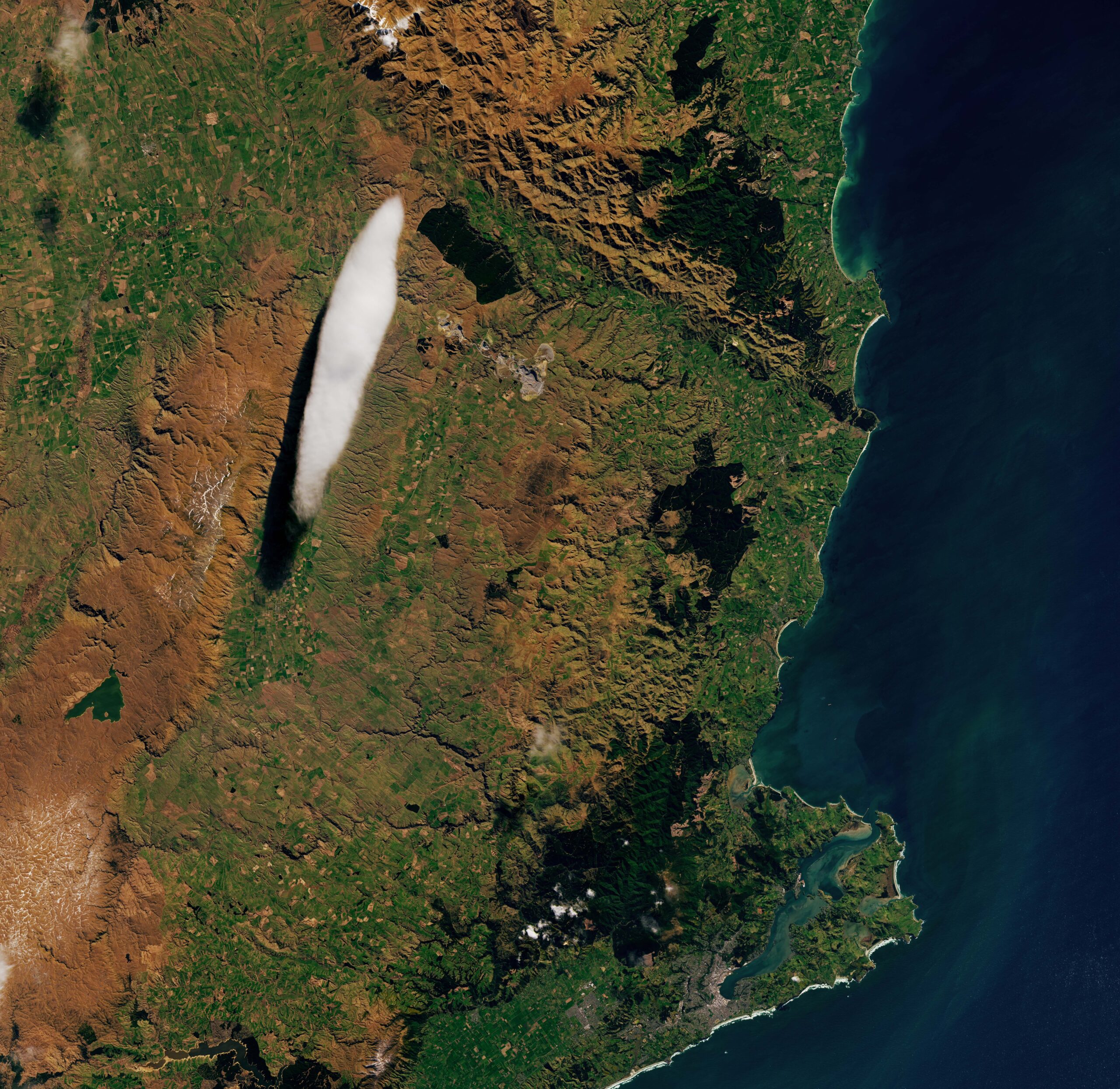Capturing Nature’s Phenomena: The Fascinating Lenticular Cloud Over New Zealand
In the realm of atmospheric wonders, lenticular clouds stand out for their unique lens-like shape and ethereal beauty. On September 7, 2024, an extraordinary image was captured by the Operational Land Imager on Landsat 8, showcasing one such cloud over New Zealand’s South Island. Locally nicknamed the “Taieri Pet,” this cloud formation presented a captivating spectacle that drew the interest of meteorologists and cloud enthusiasts alike.
Lenticular clouds are typically formed when stable, moist air flows over a topographic barrier, such as a mountain range. As the wind is forced to ascend the slope of the mountains, it creates a series of atmospheric waves. When the air reaches the crest of these waves, it cools and condenses, forming clouds. The lenticular cloud that materialized over the South Island is a classic example of this phenomenon.
The Science Behind Lenticular Clouds
To understand the formation of lenticular clouds, it is essential to delve into the dynamics of air flow and atmospheric conditions. These clouds usually appear when the air is stable and the wind direction is perpendicular to a mountain range. The process begins as the wind approaches the mountains, where it is lifted and cooled. As the air rises, it reaches a point where its temperature drops enough for the water vapor within it to condense into water droplets, forming a cloud.
Unlike typical clouds that drift with the wind, lenticular clouds often remain stationary relative to the ground. This occurs because the cloud forms at the crest of the wave, maintaining its position as long as the atmospheric conditions remain unchanged. This unique behavior gives lenticular clouds their distinctive, almost alien-like appearance, often resembling a stack of pancakes or a flying saucer.
Why Are Lenticular Clouds Important?
Lenticular clouds are not just a visual marvel; they also hold significance for weather prediction and aviation. Their formation indicates the presence of strong winds at high altitudes, which can influence weather patterns. For pilots, these clouds serve as a warning sign of potential turbulence, as the areas near lenticular clouds often experience powerful, unpredictable air currents.
For meteorologists, studying lenticular clouds provides valuable insights into the behavior of atmospheric waves and the interactions between air masses of different temperatures and moistures. Understanding these dynamics can improve forecasting models and enhance our knowledge of the Earth’s atmospheric processes.
Observing the Taieri Pet: A Local Phenomenon
The “Taieri Pet” lenticular cloud over New Zealand’s South Island was not just an isolated event but part of a fascinating meteorological pattern. The South Island, with its mountainous terrain, provides the perfect backdrop for the formation of such clouds. The region’s unique topography and prevailing wind patterns contribute to the frequent appearance of these beautiful atmospheric formations.
Locals have affectionately named this particular lenticular cloud the “Taieri Pet,” highlighting its impact on the community and the cultural connection people have with their natural environment. The name reflects a sense of ownership and familiarity, as if the cloud were a beloved local character making a regular appearance in the skies.
Capturing the Moment: The Role of Landsat 8
The image of the Taieri Pet was captured using the Operational Land Imager aboard the Landsat 8 satellite. Landsat 8 is part of a long-standing program that provides continuous data about the Earth’s surface, helping scientists monitor environmental changes and manage natural resources.
The satellite’s advanced imaging capabilities allow it to capture detailed photographs of the Earth’s atmosphere, land, and oceans. By analyzing these images, researchers can track cloud formations, study weather patterns, and assess the impact of climate change on various ecosystems.
A Closer Look at Satellite Imaging
Satellite imaging has revolutionized the way we observe and understand our planet. Instruments like the Operational Land Imager are equipped with sensors that can detect a wide range of wavelengths, including visible light and infrared. This capability allows satellites to capture images in various conditions, offering a comprehensive view of the Earth’s surface and atmosphere.
For meteorologists, satellite images provide real-time data essential for weather forecasting and climate research. They offer a bird’s-eye view of atmospheric phenomena, enabling scientists to monitor cloud formations, track storm systems, and assess the effects of natural disasters.
The Importance of Public Engagement in Science
The captivating image of the Taieri Pet highlights the importance of public engagement in science. By sharing such stunning visuals with the world, organizations like NASA and the US Geological Survey (USGS) inspire curiosity and foster a greater appreciation for the natural world.
Images of unique cloud formations can spark interest in meteorology and atmospheric sciences, encouraging people to learn more about the forces that shape our environment. This engagement is crucial for promoting scientific literacy and encouraging future generations to pursue careers in science and technology.
Conclusion: The Beauty and Science of Lenticular Clouds
Lenticular clouds, like the Taieri Pet, serve as a reminder of the intricate and beautiful dynamics of our planet’s atmosphere. Their formation is a testament to the complex interplay between wind, moisture, and topography, offering a glimpse into the fascinating world of meteorological phenomena.
As we continue to explore and understand these natural wonders, we gain valuable insights into the Earth’s climate system and the forces that drive weather patterns. By capturing and sharing images of these clouds, we not only advance our scientific knowledge but also celebrate the awe-inspiring beauty of our planet.
For more detailed information and images, you can visit NASA’s Earth Observatory.
For more Information, Refer to this article.



































